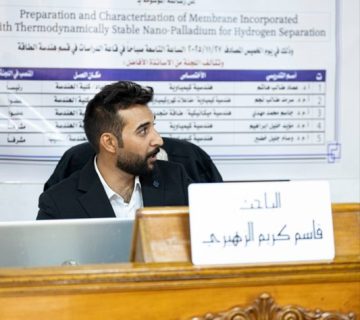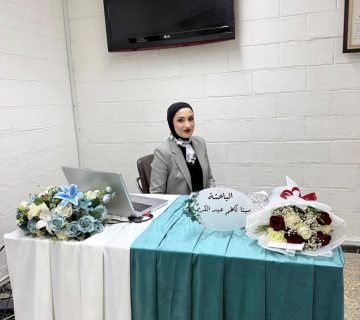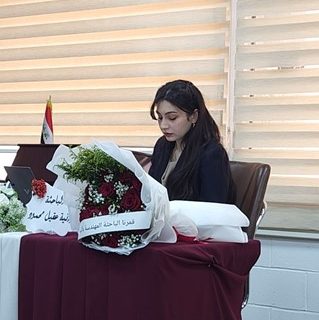Environmental Engineering Department at the College of Engineering, University of Baghdad, held MSc thesis examination titled:
“Removal of Trivalent Ions from Electroplating Wastewater using Low-cost Sorbents”
By the student Basmala Jaafar Adnan and supervised Assist.Prof. Dr. Haider Mohsen Rasheed on Monday 18/3/2024 , in the Environmental Engineering discussion hall. The examination committee consisted of Prof. Dr. Ahmed Abd Mohammed as Chairman, and the membership of Professor Dr. Ziad Tariq Abd Ali and Prof. Dr. Salim Hariz Jsam. After conducting the public discussion and listening to the student’s defense, the thesis was accepted. It was summarized as follows:
This research looks at the potential of date pits as reactive materials in water that is contaminated with cr(III) from both a theoretical and experimental perspective. Laboratory work has been done on five factors that affect the efficiency of removal, with a total sample size of 75 samples for contaminated solution and material. At room temperature (25 °C), the effects of several concentrations (25-125 mg/L), contact times (15-90 min), pH values (3-6), and shaking speeds (50-250 rpm) , particle sizes (1.1mm,250µm,600µm), and biosorption doses (0.5-2.0 g/100 ml) were studied. The parameters 90 min, pH(6.0), 25 mg/L, 250 rpm, 2 g/100 mL, and 25 °C produced maximum uptake for the metal with 95% removal efficiency from the contaminated aqueous solution. The Batch sorption data has been modeled using Freundlich, Langmuir, sips, toth, and Temkin equations. Sips adequately reflected these data points at 25 °C with R2 value (0.9996). In contrast, the Continuous model investigated the following variables and circumstances: bed height, particle size, flow rate, and initial, and how each of these impacted the adsorption and removal process. Chrome dissolved in liquids, Bed height of 14 cm, flow rate of 0.5 L/hr, and particle size of 250 µm were determined in order to attain the highest possible efficiency factors. Using two different kinetic models, namely pseudo-second-order and pseudo-first-order,the results show that the adsorption process is a chemical procedure for adsorbent date pit waste. The results of the empirical and theoretical investigations, which were conducted using these models, indicate that the interaction is of the second order when R2 value (0.972). Surface morphology and functional groups of raw date pits and produced activated carbon can be distinguished using several characterization procedures. The characterization of date pit activated carbon revealed the presence of active functional groups that were introduced onto the surface of the solid adsorbent particles. This resulted in the creation of additional active sites, an increased adsorption surface area, and larger pore sizes. The activated carbon derived from date pits exhibited surface area and pore volume values of 330.8m2/g and 8.2925 nm, respectively.
The recommendations of this thesis:
- Further research into the potential of date pits as an eco-friendly material that may remove harmful organic pollutants like phenol, trichloroethylene, etc. from the simulated wastewater.
- By utilizing a different form of local agricultural waste as an inexpensive and easily accessible adsorbent material, we may explore the adsorption of different adsorbent materials and eliminate or significantly reduce a variety of synthetic wastes, including sawdust, buckthorn paper, banana, orange, rice.
- Verify the possibility of reusing the adsorbent material several times after processing
- Experimenting with real wastewater from different organizations and studying how different components of wastewater affect adsorption efficiency.
- Study of some chemical compounds on their ability to activate date pit waste for the purpose of increasing removal efficiency.








